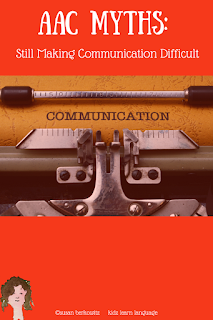Here we are more than 12 years later, and many of these myths still run rampant through our service delivery - or lack of it. Romski and Sevcik addressed the ways in which AAC can facilitate the development of children with communication disabilities.
Children need both comprehension skills and expressive skills. Routines create consistent language environments (did you read last week’s post about routines? Or this older one here?), and consistent opportunities for partners to create learning opportunities. Research by Hollich et all (2000) is cited in the article as indicating that children rely “…on comprehension to build a foundation for later productive word use.”
Romski and Sevcik list 6 myths of AAC:
1. AAC is a “last resort” in language intervention
Research has shown that it is actually important to introduce AAC before the child fails so that he has a communication mode before frustration sets in.
2. AAC hinders or stops further speech development
Research again has shown that use of AAC can actually help children develop speech.
3. Children must have a certain set of skills to be able to benefit from AAC
As the exact relationship between cognition and language is unknown, we do know that many children cannot demonstrate their abilities without a way to communicate.
4. Speech Generating Devices are only for children whose cognition is intact
Advances in technology mean that advanced cognitive skills are not necessarily needed to use high tech systems and, as a wide range of options are available, there are many tools that children can bee taught to use effectively
5. Children have to be a certain age to benefit from AAC
Again, research shows that providing children a mode of communication early is beneficial and will not hinder speech development.
6. There is a representational hierarchy of symbols from objects to written words.
Romski and Sevcik site the research that shows that children do not actually learn less abstract symbols better or faster. To the child, all symbols work the same way. We just need to teach them consistently.
(Did you read my last post about the myths here?)
Romski and Sevcik go on to discuss the important role parents play as interventionists. Certainly, family is all-important in providing intervention when children are young. The article concludes with the reminder that it is never too early to begin using AAC for language and communication support, and that AAC is a tool; not the end goal. “AAC is not a last resort but rather a first line of intervention…”
The message of this article is as important in 2018 as it was in 2005.
I, for one, am saddened that these myths still abound in our profession and in the minds of other educators. It is about time that we acknowledge that ALL children can communicate.
Please, keep on talking!




No comments
Post a Comment